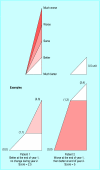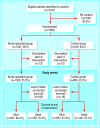Effects of community based nurses specialising in Parkinson's disease on health outcome and costs: randomised controlled trial - PubMed (original) (raw)
Clinical Trial
Effects of community based nurses specialising in Parkinson's disease on health outcome and costs: randomised controlled trial
Brian Jarman et al. BMJ. 2002.
Abstract
Objective: To determine the effects of community based nurses specialising in Parkinson's disease on health outcomes and healthcare costs.
Design: Two year randomised controlled trial.
Setting: 438 general practices in nine randomly selected health authority areas of England.
Participants: 1859 patients with Parkinson's disease identified by the participating general practices.
Main outcome measures: Survival, stand-up test, dot in square test, bone fracture, global health question, PDQ-39, Euroqol, and healthcare costs.
Results: After two years 315 (17.3%) patients had died, although mortality did not differ between those who were attended by nurse specialists and those receiving standard care from their general practitioner (hazard ratio for nurse group v control group 0.91, 95% confidence interval 0.73 to 1.13). No significant differences were found between the two groups for the stand-up test (odds ratio 1.15, 0.93 to 1.42) and dot in square score (difference -0.7, -3.25 to 1.84). Scores on the global health question were significantly better in patients attended by nurse specialists than in controls (difference -0.23, -0.4 to -0.06), but no difference was observed in the results of the PDQ-39 or Euroqol questionnaires. Direct costs for patient health care increased by an average of 2658 pounds sterling during the study, although not differentially between groups: the average increase was 266 pounds sterling lower among patients attended by a nurse specialist (-981 pounds sterling to 449 pounds sterling ).
Conclusions: Nurse specialists in Parkinson's disease had little effect on the clinical condition of patients, but they did improve their patients' sense of wellbeing, with no increase in patients' healthcare costs.
Figures
Figure 1
Selection of health authority areas. Numbers with names of health authorities are amended underprivileged area scores (excludes under 5s component)
Figure 2
Area under curve method used to combine global question responses. Participants at intersection (0,0) at baseline. Participant moves one unit along x axis during year 1. Movement on y axis determined by global health response (for example, “much better” stays on axis (1,0), “better” goes up by one unit (1,1). During year 2 participants move another unit along x axis, with movement on y axis defined same as year 1. Participant much better in each year therefore stays on x axis, moving from (0,0) to (2,0) and has an area under curve of 0 units. Participant “much worse” in each year moves from (0,0) to (2,8) and has an area under curve of 8 units. Participants getting much better in year 1 and staying same in year 2 arrive at same point (2,2) as someone staying same and then getting much better. Former patient will have higher score, however, reflecting earlier benefit
Figure 3
Participant flow through study
Similar articles
- Scientific evaluation of community-based Parkinson's disease nurse specialists on patient outcomes and health care costs.
Hurwitz B, Jarman B, Cook A, Bajekal M. Hurwitz B, et al. J Eval Clin Pract. 2005 Apr;11(2):97-110. doi: 10.1111/j.1365-2753.2005.00495.x. J Eval Clin Pract. 2005. PMID: 15813708 Clinical Trial. - Randomised controlled trial comparing cost effectiveness of general practitioners and nurse practitioners in primary care.
Venning P, Durie A, Roland M, Roberts C, Leese B. Venning P, et al. BMJ. 2000 Apr 15;320(7241):1048-53. doi: 10.1136/bmj.320.7241.1048. BMJ. 2000. PMID: 10764367 Free PMC article. Clinical Trial. - Cost-effectiveness of telephone or surgery asthma reviews: economic analysis of a randomised controlled trial.
Pinnock H, McKenzie L, Price D, Sheikh A. Pinnock H, et al. Br J Gen Pract. 2005 Feb;55(511):119-24. Br J Gen Pract. 2005. PMID: 15720933 Free PMC article. Clinical Trial. - Comparing the cost of nurse practitioners and GPs in primary care: modelling economic data from randomised trials.
Hollinghurst S, Horrocks S, Anderson E, Salisbury C. Hollinghurst S, et al. Br J Gen Pract. 2006 Jul;56(528):530-5. Br J Gen Pract. 2006. PMID: 16834880 Free PMC article. Review. - Substitution of doctors by nurses in primary care.
Laurant M, Reeves D, Hermens R, Braspenning J, Grol R, Sibbald B. Laurant M, et al. Cochrane Database Syst Rev. 2005 Apr 18;(2):CD001271. doi: 10.1002/14651858.CD001271.pub2. Cochrane Database Syst Rev. 2005. PMID: 15846614 Updated. Review.
Cited by
- Effects of Parkinson's on employment, cost of care, and quality of life of people with condition and family caregivers in the UK: a systematic literature review.
Gumber A, Ramaswamy B, Thongchundee O. Gumber A, et al. Patient Relat Outcome Meas. 2019 Oct 21;10:321-333. doi: 10.2147/PROM.S160843. eCollection 2019. Patient Relat Outcome Meas. 2019. PMID: 31695537 Free PMC article. Review. - Who should look after people with Parkinson's disease?
Kale R, Menken M. Kale R, et al. BMJ. 2004 Jan 10;328(7431):62-3. doi: 10.1136/bmj.328.7431.62. BMJ. 2004. PMID: 14715579 Free PMC article. No abstract available. - Impact of Antidepressants on Cardiac Events and All-Cause Mortality in Parkinson's Disease: A National Data-Linkage Study.
Orayj K. Orayj K. Neuropsychiatr Dis Treat. 2021 Jul 30;17:2499-2510. doi: 10.2147/NDT.S325521. eCollection 2021. Neuropsychiatr Dis Treat. 2021. PMID: 34354357 Free PMC article. - Recommendations for Standards of Network Care for Patients with Parkinson's Disease in Germany.
Prell T, Siebecker F, Lorrain M, Eggers C, Lorenzl S, Klucken J, Warnecke T, Buhmann C, Tönges L, Ehret R, Wellach I, Wolz M. Prell T, et al. J Clin Med. 2020 May 13;9(5):1455. doi: 10.3390/jcm9051455. J Clin Med. 2020. PMID: 32414071 Free PMC article. Review. - Feasibility and benefits of home initiation of subcutaneous apomorphine infusion for patients with Parkinson's disease: the APOKADO study.
Zagnoli F, Leblanc A, Viakhireva-Dovganyuk I, Delabrousse-Mayoux JP, Pouyet A, Ziegler M, Sogni L, Patat M, Bouillot R, Vérin M; APOKADO Group. Zagnoli F, et al. J Neural Transm (Vienna). 2023 Nov;130(11):1463-1474. doi: 10.1007/s00702-023-02609-6. Epub 2023 Mar 2. J Neural Transm (Vienna). 2023. PMID: 36862190 Free PMC article.
References
- Calne DB. Treatment of Parkinson's disease. N Engl J Med. 1993;329:1021–1027. - PubMed
Publication types
MeSH terms
LinkOut - more resources
Full Text Sources
Medical


